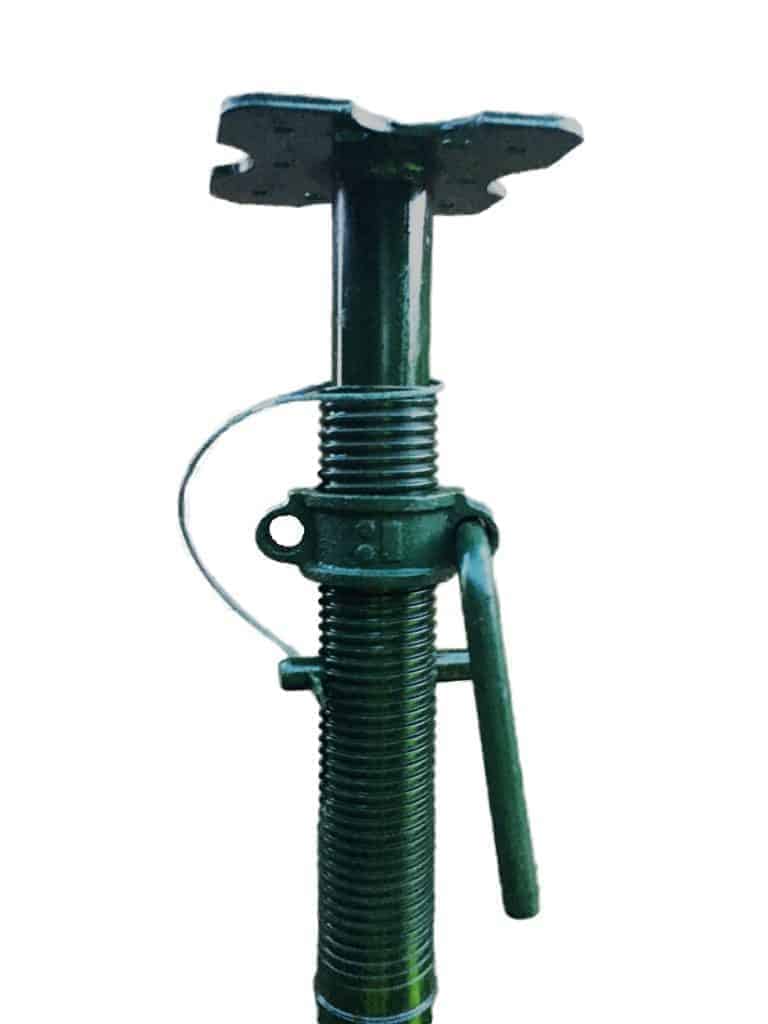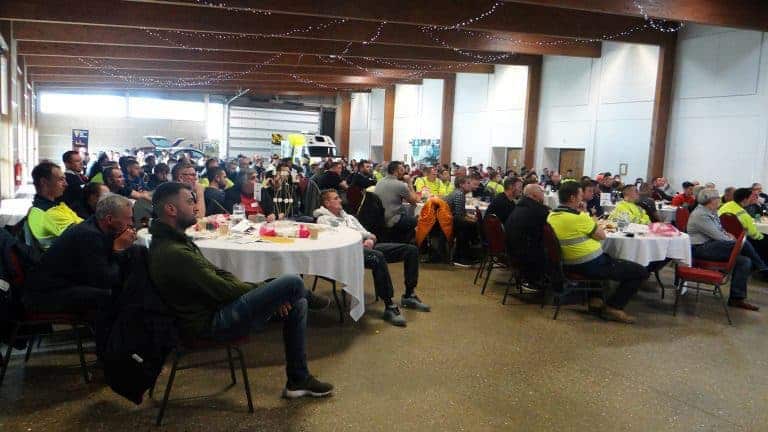Safety alert issued for Acrow Props
Expert calls for people to check any recent deliveries of Acrow Props.
A leading industry Health and Safety expert has reported a potentially life threatening issue with Acrow Props being supplied into the UK market. These uncertified Props are exhibiting various degrees of misalignment, in certain cases preventing the locating pin from passing fully through the inner and outer tubes leading to the load being unevenly and inadequately distributed. This could potentially lead to a catastrophic collapse of the supported structure. A leading technical expert comments: “This is a very serious issue that should not be understated. This is a product often bought “On Line” or hired for DIY, by individuals who are not trained experts and who would be unlikely to realise the Prop was not functioning correctly until it was too late.”Rilmac Scaffolding round off successful year with nationwide training event
Lincolnshire based Rilmac Scaffolding rounded off an excellent year with a highly successful group wide training day at the end of December.
Rilmac Employees from all across the country converged on the Epic Centre, at the Lincolnshire Showground for sessions on Health & Safety, Behavioural Change, and Working At Height. Rilmac Scaffolding say they have a history of running their own training days, but this was the first time all the Rilmac Companies have met together en masse, and it proved to be very successful according to the firm. Rilmac’s Group chairman Paul Walker opened the day addressing their 250 employees in attendance, the largest gathering of Rilmac staff in its 60-year history. Guest speakers from Clarkes Health & Safety Consultants, Kier, Galliford Try, ARCA and Lincolnshire Road Safety Partnership presented throughout the day along with individuals from the Rilmac Group.
Speaking after the event Rilmac Scaffolding Managing Director, Des Booth said, “We value all our staff and aim to grow from within. Most of our supervisors, managers, estimators plus our directors have all worked as scaffolders. Days like these aid in the development and growth of all our employees.”
“Safety is our first priority,” added Contracts Manager Dave Clarke, “and it is fantastic to see it approached from different and worthwhile directions. This really has been an excellent day for everyone at Rilmac Scaffolding.”
The Directors and Management across all the Rilmac companies expressed their thanks and gratitude to Mark Clarke, Clare Davey, Steve Spedding, Geoff Silver and John Siddle for their excellent contribution on the day.
Rilmac say they are determined to grow on the success of their first group wide training day and plans are already underway for the next one in December 2018.
Rilmac’s Group chairman Paul Walker opened the day addressing their 250 employees in attendance, the largest gathering of Rilmac staff in its 60-year history. Guest speakers from Clarkes Health & Safety Consultants, Kier, Galliford Try, ARCA and Lincolnshire Road Safety Partnership presented throughout the day along with individuals from the Rilmac Group.
Speaking after the event Rilmac Scaffolding Managing Director, Des Booth said, “We value all our staff and aim to grow from within. Most of our supervisors, managers, estimators plus our directors have all worked as scaffolders. Days like these aid in the development and growth of all our employees.”
“Safety is our first priority,” added Contracts Manager Dave Clarke, “and it is fantastic to see it approached from different and worthwhile directions. This really has been an excellent day for everyone at Rilmac Scaffolding.”
The Directors and Management across all the Rilmac companies expressed their thanks and gratitude to Mark Clarke, Clare Davey, Steve Spedding, Geoff Silver and John Siddle for their excellent contribution on the day.
Rilmac say they are determined to grow on the success of their first group wide training day and plans are already underway for the next one in December 2018. Scaffolder dies instantly after dumper truck crush
Top Construction And Engineering Firms Awaiting Sentencing Following Tragic Death Of Scaffolder
Sentencing over serious health and safety breaches involving Both housebuilder Redrow and sub-contractor WPI Civil Engineering has been adjourned until February 9th. Liverpool Crown Court heard how Harry Jones a 67-year-old scaffolder was killed instantly after a dumper truck driven by an unqualified driver reversed into him. The tragedy in August 2013 was also witnessed by Mr Jones’s son Christopher, who was working at the construction site of Redrow Homes’ Summerhill Park housing development in Knotty Ash. Mr Jones suffered fatal crush injuries when he went under the wheels of the truck and was pronounced dead at the scene. Following an investigation by the Health and Safety Executive (HSE), the companies pleaded guilty to the health and safety breaches, involving the 43-ton six wheeled truck. The court was told it was driven by an inexperienced, unqualified driver and was being reversed because the turning circle was full of building detritus. Although its reverse alarm was sounding, Mr Jones suffered serious hearing problems and had his back to the vehicle when he was hit. Kevin Donnelly, prosecuting, said safety procedures were not followed at the building site, which meant vehicles – including heavy plant machinery – and workers on foot were not kept apart. He said: “Both employees and non-employees were exposed to significant risk of harm. “There was inadequate management of site activity to minimise the risk of collision between pedestrians and vehicles. “This placed those who were working on site at risk of being struck by site vehicles, which could and should have been avoided.” John Cooper, QC, representing Redrow Homes, said: “The company recognises its safety responsibilities and is anxious about those who work on its sites, from the top down. This was a rare and regrettable failure.” Dominic Kay, QC, representing WPI, said: “It’s a source of enormous regret to WPI that someone lost their life as a result of its failings. It’s a family business and has been hit very hard indeed by the accident. It has been trading for 40 years without a previous conviction and takes health and safety very seriously.” Following the case, HM Inspector of Health and Safety Jacqueline Western said: “It’s entirely foreseeable that if traffic management and pedestrian segregation is not properly implemented on site, that incidents like this will occur.” Mr Jones leaves three children, 11 grandchildren and seven great-grandchildren. Family members from Westhoughton near Bolton were present at the proceedings. The recorder, Judge Clement Goldstone, QC adjourned sentencing until next month.ScaffMag’s most read stories of 2017
As 2017 edges ever closer to an end, we take a look back at what most attracted your attention during the year.
This year has been another busy news filled year for the scaffolding industry as ScaffMag continues to keep you updated with what’s going on. Either on desktop, mobile, tablet or in our digital magazine, we have you covered. During the year we saw several stories that stood out and received a lot of attention. One of which was our tongue-in-cheek April fools post on London based MR Scaffolding Services winning the scaffolding contract for the controversial President Donald Trump’s wall between the United States and Mexico. In addition also on our list of the biggest stories of 2017 were; Altrad’s purchase of Cape plc, news of London’s Big Ben project, the death of Safelinx inventor and the closure of Bircham Newton to name a few. For a full rundown of ScaffMag’s top 10 biggest stories including page views and social shares see below.Best read stories of 2017
1. Pageviews: 23,322 | Facebook Shares: 1,462 | Linkedin: 878
UK Scaffolding Company Seal Biggest Ever Scaffolding Contract
2. Pageviews: 11,968 | Facebook Shares: 364 | Linkedin: 475
Shocking Video: Man Pulls Scaffolding Over onto Busy Street
3. Pageviews: 9,894 | Facebook Shares: 8 | Linkedin: 379
Scaffolder loses leg and arms after being electrocuted
4. Pageviews: 9,537 | Facebook Shares: 445 | Linkedin: 337
Three-year Scaffolding Project Gets Underway at Big Ben
5. Pageviews: 9,212 | Facebook Shares: 528 | Linkedin: 332
Three plunge into water after bridge scaffolding collapses
6. Pageviews: 8,947 | Facebook Shares: 380 | Linkedin: 298
Worker killed after falling from scaffolding in Kensington
7. Pageviews: 6,321 | Facebook Shares: 287 | Linkedin: 677
Industry Stunned After Death of Safelinx Inventor
8. Pageviews: 5,782 | Facebook Shares: 515 | Linkedin: 218
Scaffolder fighting brain tumour warns others to have a health check
9. Pageviews: 4,678 | Facebook Shares: 153 | Linkedin: 1,015
SGB Wins Major Scaffold Contract Worth £13M
10. Pageviews: 4,450 | Facebook Shares: 380 | Linkedin: 196
Bircham Newton to Close After Major CITB Shake-UpThe website will be updated with any major stories over the christmas period until the 3rd January when full service will resume. We would like to wish all our valued readers a very Merry Christmas and very happy New Year.
Safety & Access to open 2nd Oman scaffolder training centre
Safety & Access Ltd is to open a brand-new scaffolder training centre in the Rosayl region of Oman.
The CISRS Overseas Scaffolder Training Scheme (OSTS) centre will open for business early in 2018. The venture will be the 2nd Partnership for UK Provider Safety and Access Ltd within the region and will complement their other facility located in Nizwa. The new centre will be operated in collaboration with local company Knowledge Grid LLC who already offer a wide range of both Health and Safety and practical training and qualifications including Nebosh, IOSH, Lifting and Hoists. Mark Luddington, Access and Lifting Manager of Knowledge Grid in Oman stated: “Knowledge Grid are dedicated to reducing injuries, accidents and environmental impact and also ensuring compliance with local and international regulations. We look to achieve this by providing high-quality training. Our partnership with Safety and Access allowing us to deliver CISRS OSTS will help us to achive these aims within the scaffolding sector.” There is a growing demand for recognised accredited training within the region. Rick Statham Joint Managing Director for Safety & Access commented: “We are delighted to be able to offer training from this second facility. The existing Centre has been open for almost 12 months and is proving a great success. The ability to offer training close to Muscat is key to meeting the overall demand. There has been a fantastic commitment from the Oman government to provide funding for Oman nationals to achieve recognised qualifications and the new Centre will certainly help to facilitate that.” The CISRS pre-accreditation audit of the facilities was undertaken by Dave Mosley from CISRS earlier this month and he was impressed with the commitment that the local partner Knowledge grid had shown in sourcing a new venue away from their main centre and transforming it from an empty warehouse style unit into a CISRS OSTS training centre. He said: “The centre is almost ready to go with only a few minor actions required, once these have been completed, Safety and Access/Knowledge Gird will have an excellent facility. A new toilet and shower block and also a new dining area are currently being installed. If you see the images of what the building looked like when the training providers first acquired it compared to what it looks like now you realise the time, effort and commitment that has gone into achieving CISRS accreditation.” During the visit CISRS and Safety and Access took the opportunity to meet with some of the local stakeholders such as Petroleum Development Oman (PDO) and the local accreditation body. Presentations were delivered to highlight the OSTS training content and the growing success of the international scheme overall. PDO have agreed to include a requirement for CISRS OSTS qualification for their future projects within the region.Interserve awarded five year contract extension with RWE
Interserve has won a five year deal worth in excess of £2 million with power generation firm RWE.
Interserve will continue to provide a wide range of facilities services to one of RWE’s power stations in Pembroke, South Wales; including scaffolding, access solutions, thermal insulation, industrial and office cleaning, and pest control management. The power station is one of Europe’s largest and most efficient combined cycle gas turbine (CGGT) plants. At 2200MW, it plays an important role in the UK’s energy supply, able to respond quickly to the market to provide a highly flexible and reliable source of energy to over 3.5 million households. Interserve has worked with RWE for over five years, forming a strong working partnership. The recently awarded contract extends this working relationship for a further five years and will continue to see Interserve innovate and support the business’ long-term requirements. Scott Hardie, operations director – infrastructure and industrial, at Interserve said: “Our comprehensive knowledge in the combined cycle gas turbine market (CCGT) has enabled us to deliver a proficient and sustainable model, ensuring RWE’s operations run efficiently. Our relationship with RWE will continue to provide effective solutions to one of the largest and efficient plants in Europe.”NASC Health & Safety Awards winners revealed
TV star of the Apprentice and new NASC President hand out highly-prized Health & Safety Awards at AGM.
TV star of the BBC show the Apprentice, football director and business woman Karren Brady CBE, and newly appointed NASC President Des Moore presented the safety awards. Attendees to the NASC AGM held at the Intercontinental Park Lane, London on Friday 24 November 2017, saw the winners receive their awards. The well-established and highly-prized Health & Safety awards are a regular in the NASC calendar. The confederation say their contracting members of all types and sizes were urged to submit entries for the awards, and this year, in order to encourage more smaller organisations to enter, the award was split into two categories, 1-66 Employees and 67+ Employees. A total of nine entries were submitted across both categories. ScaffMag has learnt that the NASC Health & Safety Awards 2017 requirement was that entering members had to: demonstrate how directors and senior management had taken an active and leading role in promoting health and safety in their organisation. Show how their organisation investigates health and safety incidents and near misses also how lessons learned are implemented. Also show how their organisation works in accordance with guidance outlined in SG4:15, with provision of examples to demonstrate how this is promoted to the workforce.1-66 Employees Category
Winner Malvern Scaffolding Ltd Highly Commended Complete Access (Scaffolding) Ltd (Wakefield)
67+ Employees Category
Winner Actavo (UK) Ltd Highly Commended Trad Southern Highly Commended Wood Group Industrial Services Ltd
Generation Supply UNI Roof for Middle Temple Project
Generation was approached by their client UPR Services to supply scaffolding tubes, fittings and boards, along with the Generation UNI Roof, to help complete a project on one of the prestigious grade I listed Middle Temple buildings. The Middle Temple’s buildings are ancient Inns of Court located in the heart of London; today they are designated conservation areas creating a peaceful retreat from the hustle and bustle of the City. Generation was honoured to be have been approached to work on the beautiful grade I architectural structures.
Generation supplied 120,000ft of tube, 24,000 fittings and 3,000 scaffold boards as well as the famous Generation UNI Roof. It was fundamental for Generation to provide quality products and high levels of protection whatever the weather. Generation’s large and reliable delivery fleet ensured that the correct stock was delivered when and where it was needed.
The nature of this project demanded a safe, quick and easy temporary roof system that could be erected and dismantled with minimum impact to the grade I listed building. From start to finish the project took a total of 8 weeks to complete. The use of the Generation UNI Roof made for a seamless project that was achieved in record time; demonstrating once again why the Generation UNI roof is the best solution in temporary roofing on the market.
Brian Skelton, Managing director of UPR Services stated ‘the time to erect the temporary roof was approximately 50% quicker compared to previous temporary roofing suppliers’.
To be able to work on the Middle Temples estate it is compulsory for companies to meet certain criteria. Companies require a proven track record of consistently producing work to a high standard as well as being fully compliant with all H&S legislation amongst much more testing criteria. We are proud that Generation meet these high expectations and helped to make this project achievable.
To find out how the Generation UNI Roof can help your business generate profits, talk to Generation today!














